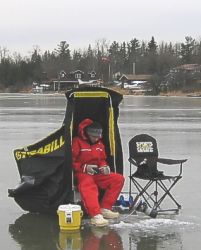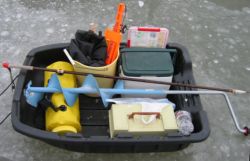Ice Fishing Equipment Overview
By Tim Allard
Cold hands and feet, dead minnows, and no fish
landed - these are just a few things that can go wrong if you're not
prepared for your next ice fishing outing. Ice fishing is a lot like
home repairs, if you don't have the right equipment to do the job,
things can quickly get ugly and, in some cases, dangerous. This
article is an overview to ice fishing equipment and gear, along with
some tips to stay comfortable this winter season.
Shelter
In bitter cold temperatures, shelters allow you to escape
winter's elements, blocking wind, snow, and light. The latter can
increase your visibility, making the bottom, and sometimes fish,
noticeable when fishing shallow, clear water. A wooden hut is a
classic, Canadian winter image and these can be productive if you're
on prime structure. On the other hand, portable shelters allow
anglers to fish various spots. The latest portable shelter designs
feature durable, easy-folding models available from basic to
advanced models.

The author seeks shelter from heavy winds in a
portable shelter. A survival suit and a small heater help keeping
him comfortable
Electronics
Like shelters, portable depth finders are also popular among
serious ice anglers. Finders are available in packages with cases
and transducers specifically designed for ice fishing. Use finders
to locate key structure, such as points or shoals, before drilling
your holes. Once set-up, keep and eye on your finder to monitor
activity and, on sensitive models, the depth of your lure. A GPS
unit is a good tool to keep track of your fishing spots, allowing
you to store waypoints and routes so you can return to the honey
hole. Batteries will drain faster when used in cold temperatures, so
bring fresh ones for each outing.
Augers, Chisels and Skimmers
"Should I buy a gas or manual auger," is a question many ice anglers
will eventually ask themselves. Gas powered augers quickly drill
clean holes, yet they are more costly and heavier than manual ones.
Inexpensive, light manual ones are great for starting out, but
drilling several holes, especially through thick ice, can tire you
out. Regardless of your choice, auger maintenance includes: keeping
your blades sharp, drying blades to avoid rust, and avoiding
dropping the auger on its blades. Another tip is to have a brush or
a rag for cleaning blades. I've seen anglers brush ice away from
sharp blades only to cut, and ruin, their gloves. An ice chisel can
be used to break through a few inches of ice when returning to the
same holes after a few days. While fishing, use an ice skimmer to
keep your holes from freezing over.
Tackle
Quality rods and tip-ups will allow you to detect subtle hits.
High-end reels will have better drag systems. Look for line
specifically designed for cold temperatures. Warm weather lines will
tangle and kink in the cold. Your tackle selection should contain
lures in varying sizes and colours that allow you to fish
presentations at various speeds, actions and depths.

Tip ups allow you to fish a large area, spreading
out your holes to properly fish structure
Bait
Keep your bait fresh and switch it often, as lively bait can dictate
success when ice fishing. A minnow bucket with an aerator will keep
minnows alive during the drive to your destination and while
fishing. Although often overlooked and only a few dollars, a minnow
net with a floating handle is a luxury when fishing in the winter.
Mobility
Motorized, recreational vehicles, such as snowmobiles or ATVs, are
excellent for covering large distances, but exercise caution when
traveling on ice. If you walk when ice fishing, a sled is an
excellent way to move your gear. There are sleds specifically
designed for ice fishing but a large child's sled will perform just
as well. Use bungee cords to keep your gear tied down. A walking
stick can help you maintain balance your on uneven and slippery
terrain.

Sleds allow you to pull your ice fishing gear
instead of carrying it, making trips less strenuous.
Clothing
When choosing clothing, look for synthetic, moisture wicking
material as a base and dress in layers to control your temperature.
Avoid wearing cotton. Cotton absorbs moisture and damp clothing
against your skin will chill you. The body's extremities often get
cold first. Hand warmers tucked in mittens will keep hands toasty.
To keep your feet warm, apply baby powder to them before putting
your socks on. The powder absorbs moisture, keeping your feet dry
and warm. During ice-out, when slush and water cover thick ice, make
sure you're wearing waterproof boots.
Safety
Safety beckons the use of lifejackets or floatation suits. Suits may
seem costly, but it's a small price if they save your life. Survival
suits also have a great outer shell, blocking the wind to help keep
you warm. Throw ropes, ice picks and a first aid kit are three other
pieces of gear to carry when ice fishing. Finally, sunglasses, water
and sunscreen are critical during ice-out. Spring sun reflected off
the ice can quickly cause sunburns so reapply often.
Miscellaneous
A bucket seat or chair will give your feet and back a rest. A small,
propane heater is handy to keep winter's chill from setting in;
however, exercise caution if using one in a shelter. The small space
can quickly fill up with carbon monoxide, a byproduct of these
heaters, and a serious health threat.
Ice fishing can be a great experience. There's nothing better than
catching lots of fish with friends on a crisp, sunny, winter's day.
Take some time to prepare for winter conditions by ensuring you have
the proper equipment and gear to stay comfortable, and safe, this
season.
Don't forget to visit
www.ontarioicefishing.net
Dymara also has some DYNAMITE ice fishing jigs!! |